Originality.AI’s Detector Review: Accuracy Shown in 3 Test

Originality.ai is a popular tool for checking whether content is human-written or AI-generated. But how accurate is it really?
In this article, I put it to the test, dig into its features, and compare it with other AI detectors. If you’ve ever wondered what it can actually do—or where it might fall short—stick around. I’ll walk you through everything so you’ll know exactly what to expect.
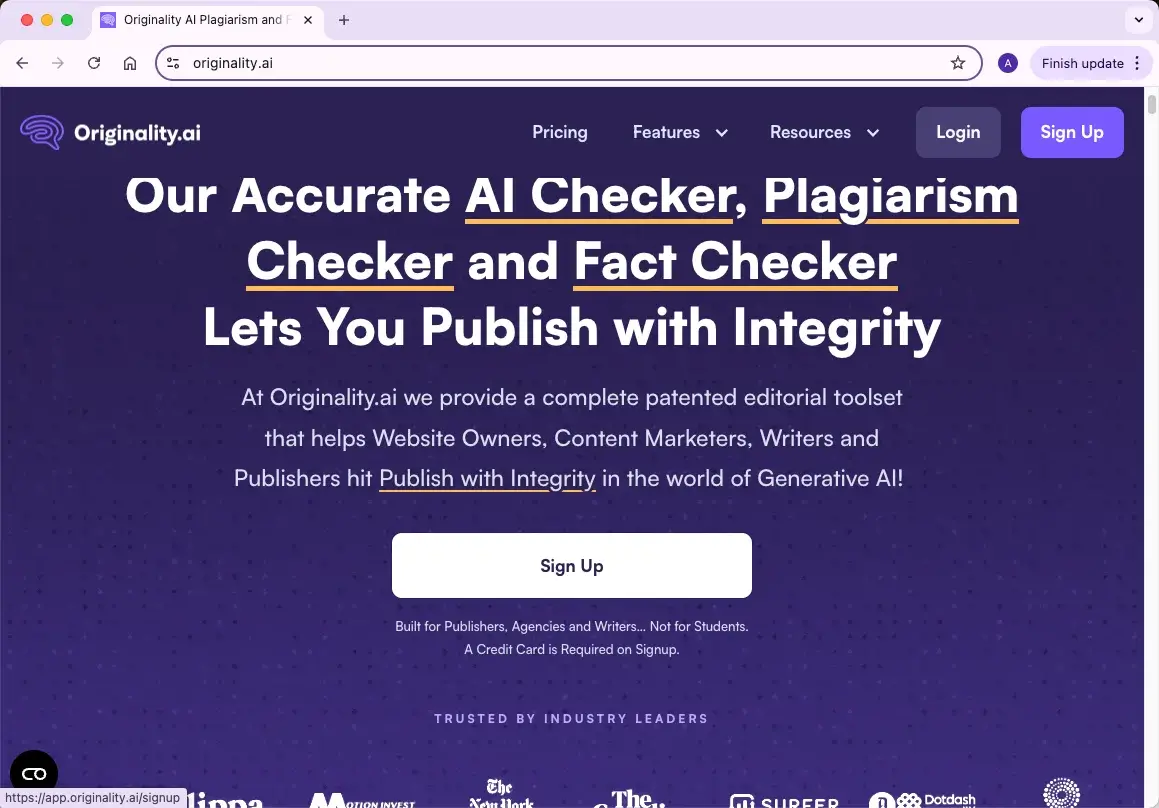
What is Originality AI?
Originality AI is an online tool designed to help writers, editors, and publishers check whether content is written by a human or generated by AI. Beyond detection, it also provides tools for plagiarism, fact-checking, and readability analysis.
What is Originality AI Content Scanner?
Originality AI’s content scanner focuses on identifying AI-generated content with a high level of accuracy, particularly for published material like blog posts, articles, or web content. The detector analyzes the text’s flow, coherence, and likelihood of being machine-generated, helping users ensure that their writing appears natural and human-authored.

How Does It Work?
Core Function: The AI detector uses advanced machine learning to evaluate whether a piece of text was produced by an AI. It calculates a probability score, indicating how likely the content is AI-generated.
Supported Formats: Users can either paste text directly, upload entire documents, or integrate detection into their workflow using the API.
Multilingual Support: While primarily built for English content, Originality AI can also process other languages including Spanish, French, Italian, and Russian.
Accuracy Claims: The tool reportedly achieves high accuracy on models like GPT-4 and ChatGPT, although user experiences vary, with some reporting false positives in highly polished human writing.
Extra Tools of Originality AI
Originality.ai is more than just an AI detector. It includes:
Plagiarism Checker: Identifies copied or paraphrased content, providing URLs and detailed matching reports. It handles complex plagiarism types like patchwork and mosaic plagiarism.
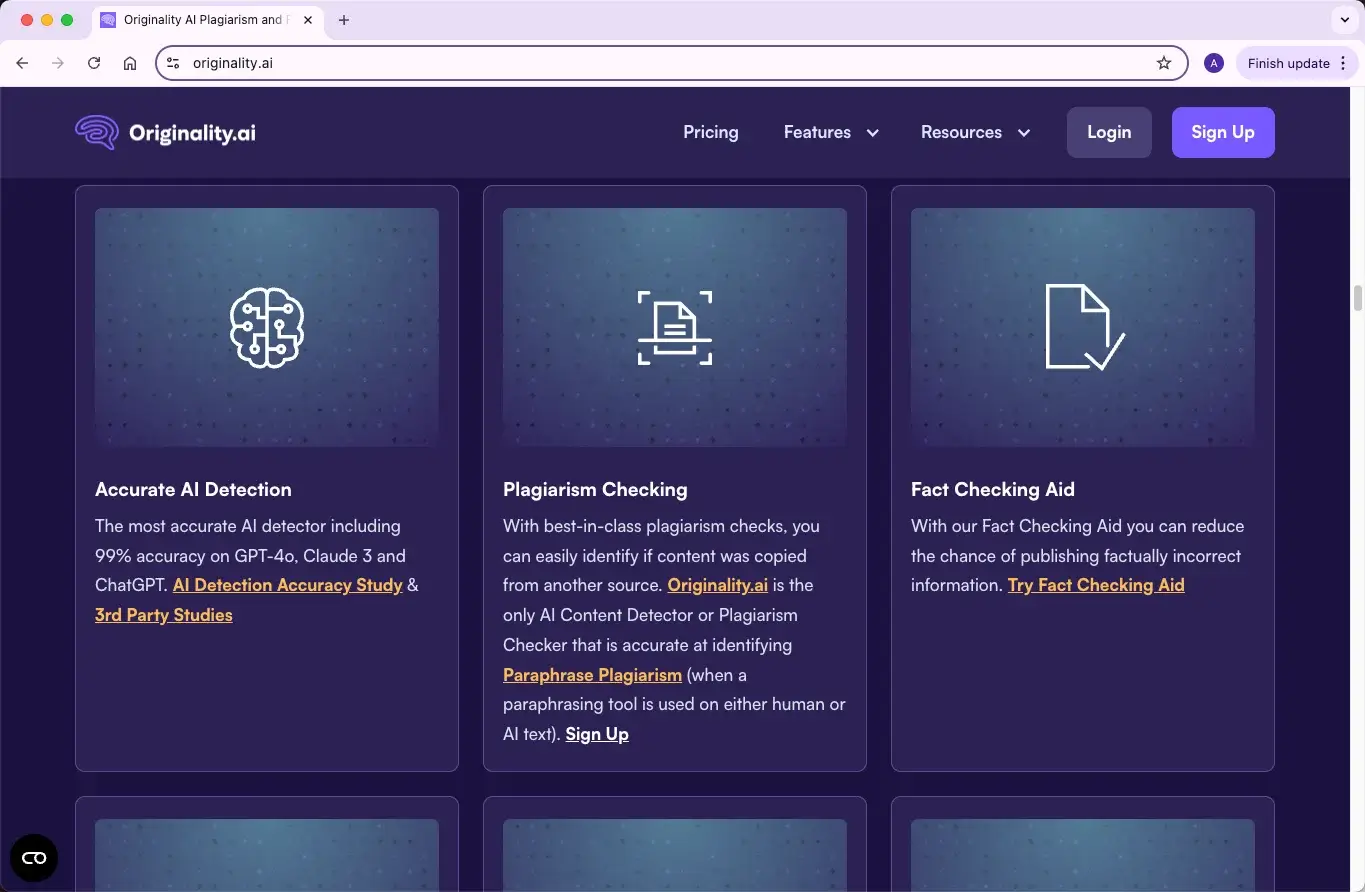
Fact Checker: Offers real-time verification of claims, flagging potentially true or false information to help maintain credibility.
Readability Checker: Evaluates how easy the text is to read, highlighting overly complex words or sentence structures and offering tips for improvement.
Other Features: Grammar Checker, Bulk Scan, Content Optimizer, and AI Humanizer help ensure content is accurate, original, and reader-friendly.
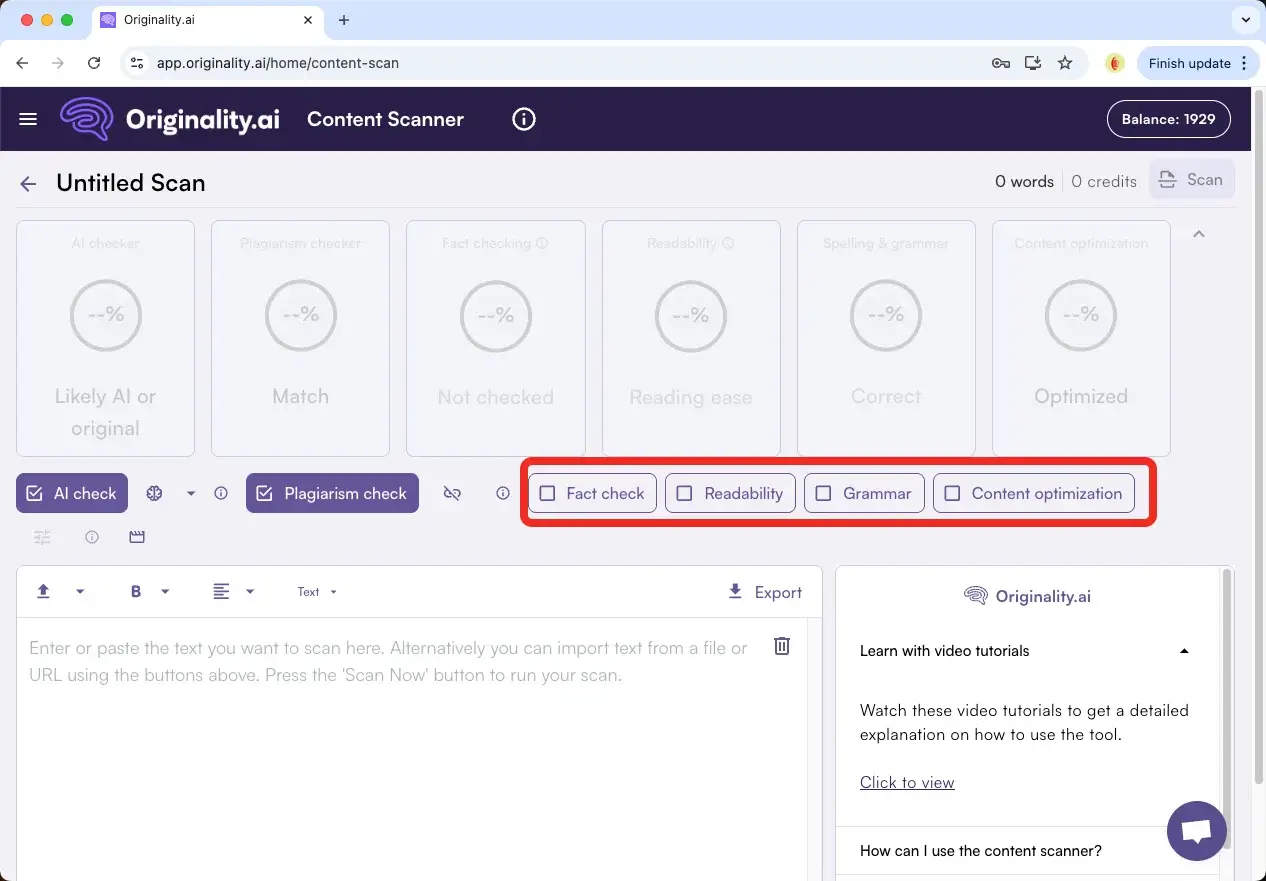
How Accurate is Originality AI Detector?
Originality AI makes a bold claim: it says its detector can spot AI writing with up to 99% accuracy on models like GPT-4, Claude 3, and ChatGPT. That’s impressive on paper, but I wanted to see how well it actually performs when put to the test.
To do that, I ran three different experiments: one with text written entirely by AI, another that mixed human and AI writing, and a final one where I tried to disguise AI text with a humanizer tool. Let’s walk through each case and see how the detector responded.
Test 1: Pure AI Text
Setup: For the first test, I kept it simple. I asked ChatGPT-5 to generate a polished passage, the type of writing many students or bloggers might rely on when they use AI directly.
Results: When I ran this through Originality AI, the detector scored it at 100% Confidence Likely AI.
My Take: This result makes sense. The text was fully machine-written, so catching it was the expected outcome. At least in straightforward cases like this, Originality AI seems to live up to its accuracy claims.
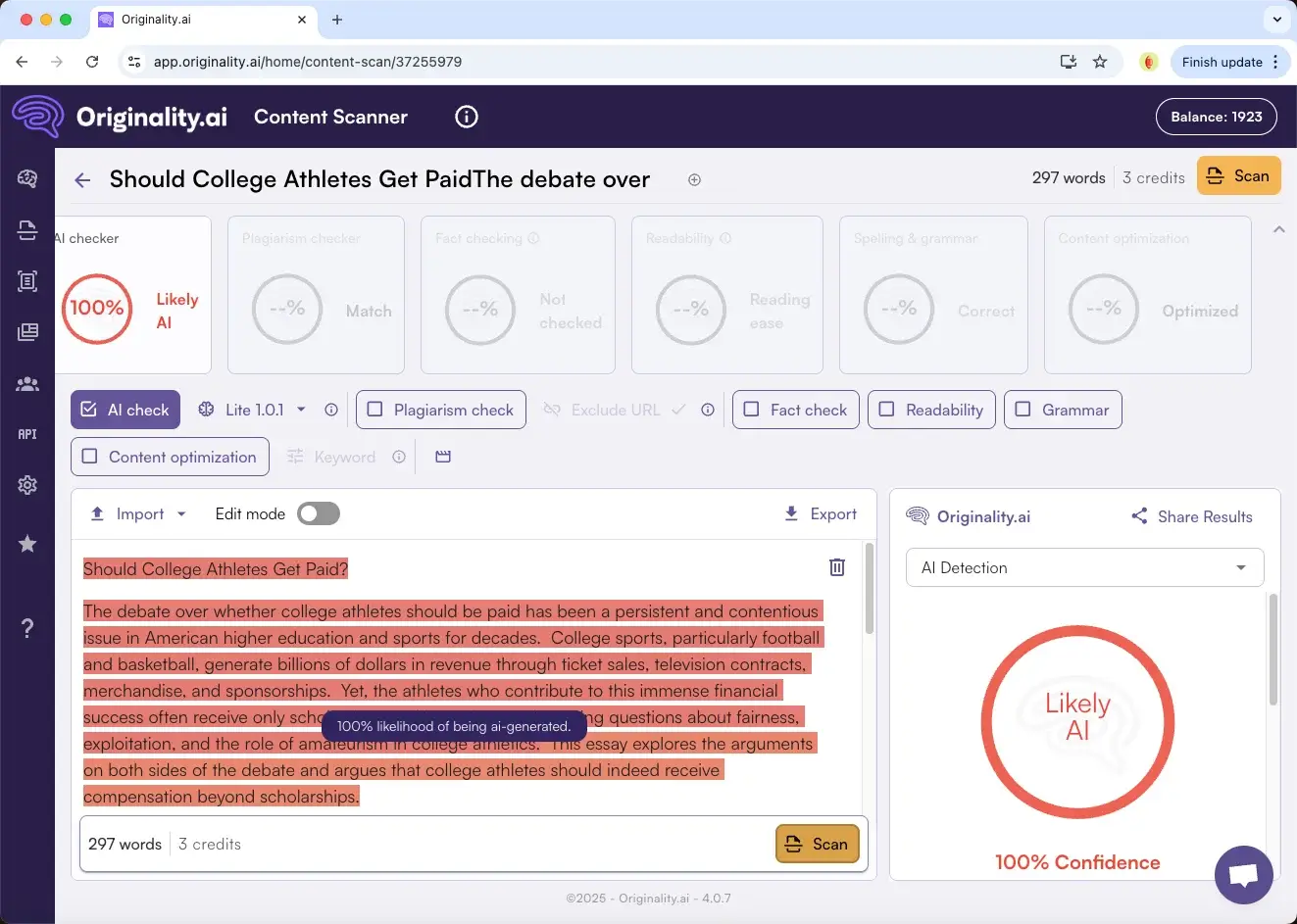
Test 2: Mixed AI + Human Writing
Setup: For the second test, I wanted to see how the detector handles blended content. I took an old essay paragraph I wrote before AI tools were around, then asked ChatGPT-5 to continue the passage. The final result ended up being 187 human-written words (41%) out of 454 total words.
Results: Originality AI came back with a score of 96% Confidence Likely AI.
My Take: This one is trickier. Technically, the detector wasn’t wrong—the text was almost 60% AI—but it essentially ignored the fact that a good chunk of the passage was human-written. That means if you’re combining your own writing with AI assistance, Originality AI may lean toward labeling the whole thing as AI-generated. For students or professionals trying to prove originality, that could be frustrating.
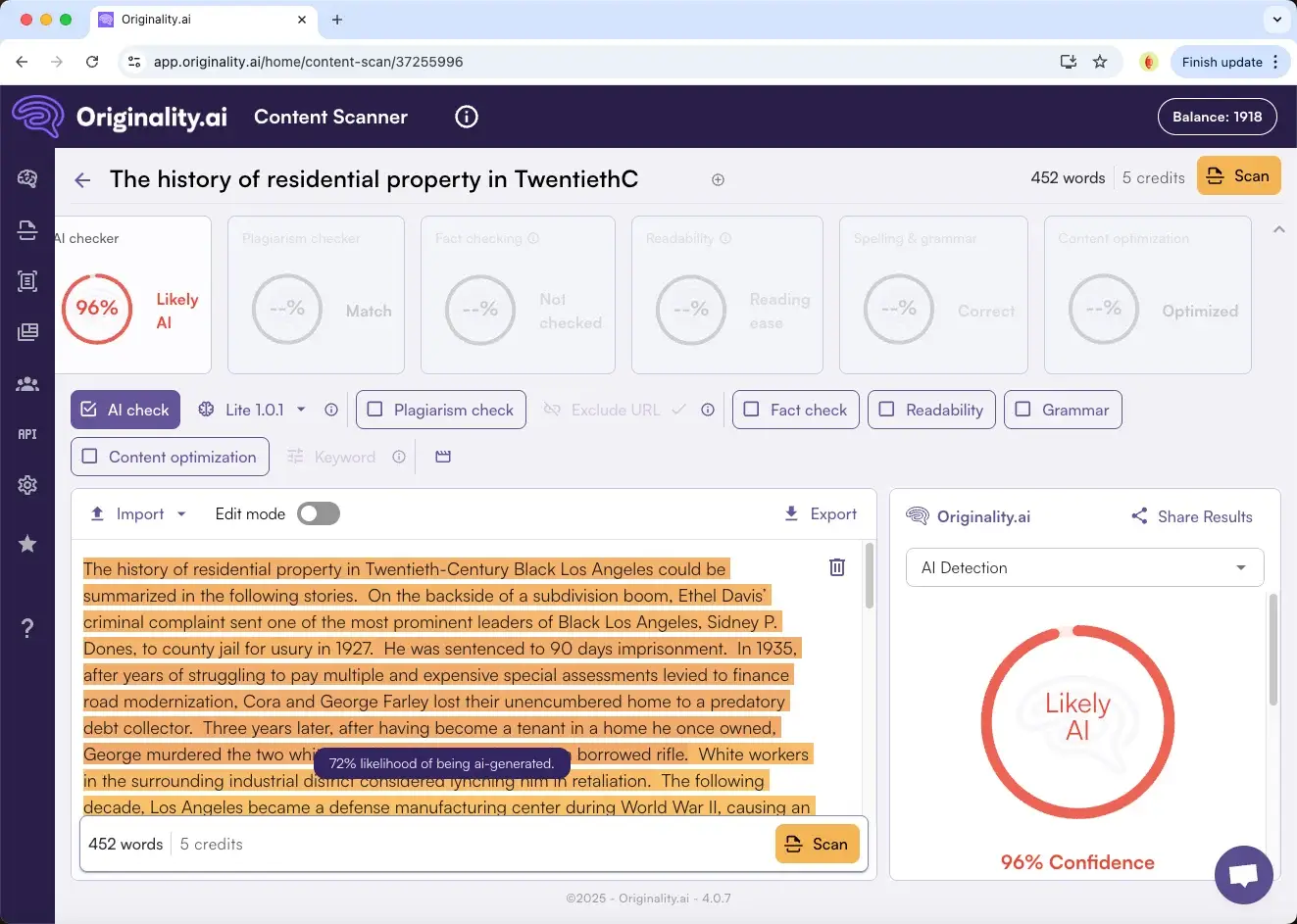
Test 3: Humanized AI Text with QuillBot
Setup: For the last test, I wanted to see if I could outsmart the detector. I took the fully AI-generated passage from Test 1 and ran it through QuillBot’s Advanced Humanizer mode. The goal here was to see if rephrasing would make the text pass as human.
Results: Originality AI wasn’t fooled—it still flagged the passage as 100% Confidence Likely AI.
My Take: I have to admit, I was impressed here. Even after QuillBot reworded the text, the detector still spotted it as AI. That tells me Originality AI doesn’t just rely on surface-level word changes; it looks deeper into patterns in the writing. On the flip side, this also shows just how strict it can be—if you’re hoping to “mask” AI text, you’ll probably have a hard time with this tool.
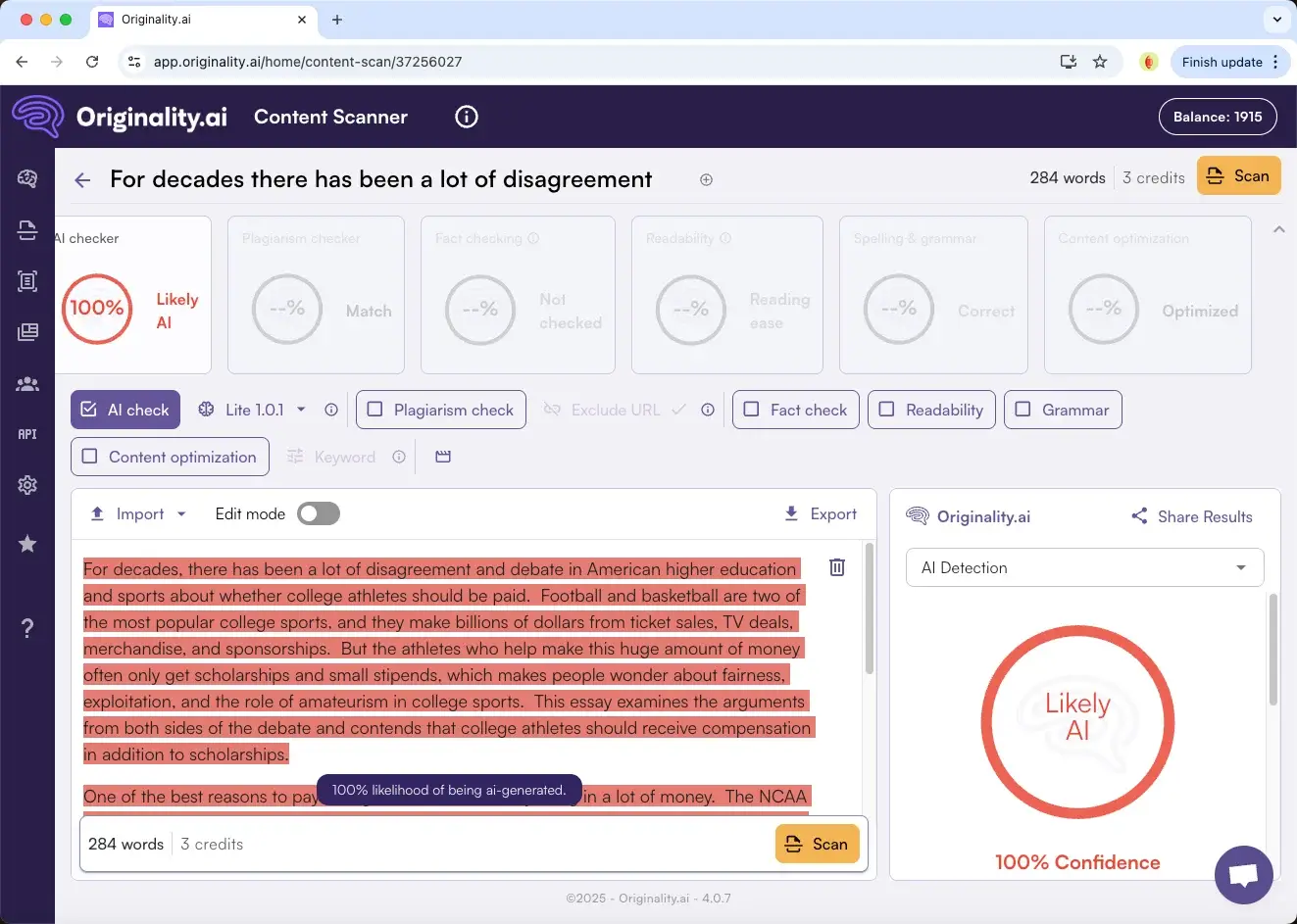
Pros and Cons of Originality AI Detector
After running my own tests and digging into what other users are saying on forums and review sites, I’ve put together a breakdown of where Originality AI shines and where it falls short. Like most tools, it’s not perfect, but knowing its strengths and weaknesses can help you decide if it’s worth using.
Pros
Solid Accuracy with AI Text: From my own experiments, it nailed pure AI content every time, even when I tried disguising it with a humanizer. That makes it one of the more reliable detectors for straightforward cases.
User-Friendly Interface: The platform is clean and easy to navigate. Even if you’ve never used an AI detector before, you can figure it out in minutes.
Sentence-Level Scoring: One handy detail is that it doesn’t just give you an overall score—it breaks down results by sentence. This lets you see exactly which parts of your text look “AI-like” and which ones seem more human, making it easier to edit or revise.
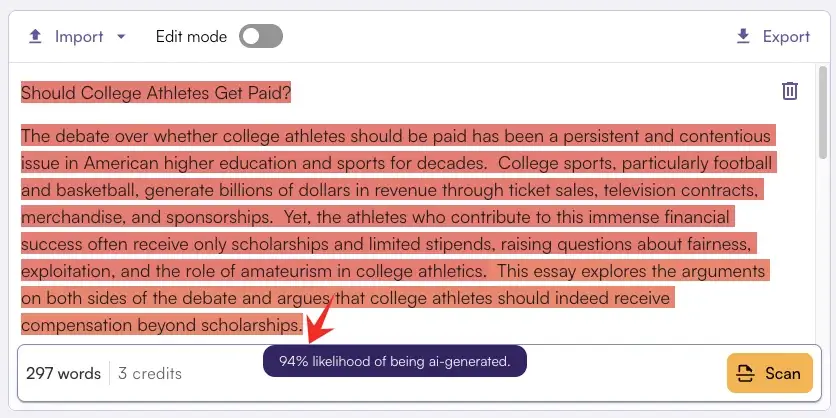
Extra Features Beyond Detection: This is where Originality AI stands out. Along with the AI detector, you get plagiarism scanning, readability scoring, and even a fact-checking tool. If you’re publishing online, these extras can save you from embarrassing mistakes.
Team and API Options: For people running a content team, there are built-in tools to manage writers, share reports, and even integrate the detector into your workflow with their API.
Good at Catching Rephrased AI: Unlike many free detectors, it wasn’t fooled by QuillBot in my test. If you’re concerned about writers trying to “hide” AI content, this is a real advantage.
Cons
False Positives with Mixed Writing: This was the biggest drawback I noticed. If you mix your own writing with AI, it tends to overestimate the AI portion. That could be stressful in academic settings where proving your own authorship matters.
Cost Adds Up Quickly: Originality uses a credit system, and every scan costs credits—whether it’s AI detection, plagiarism, or fact-checking.
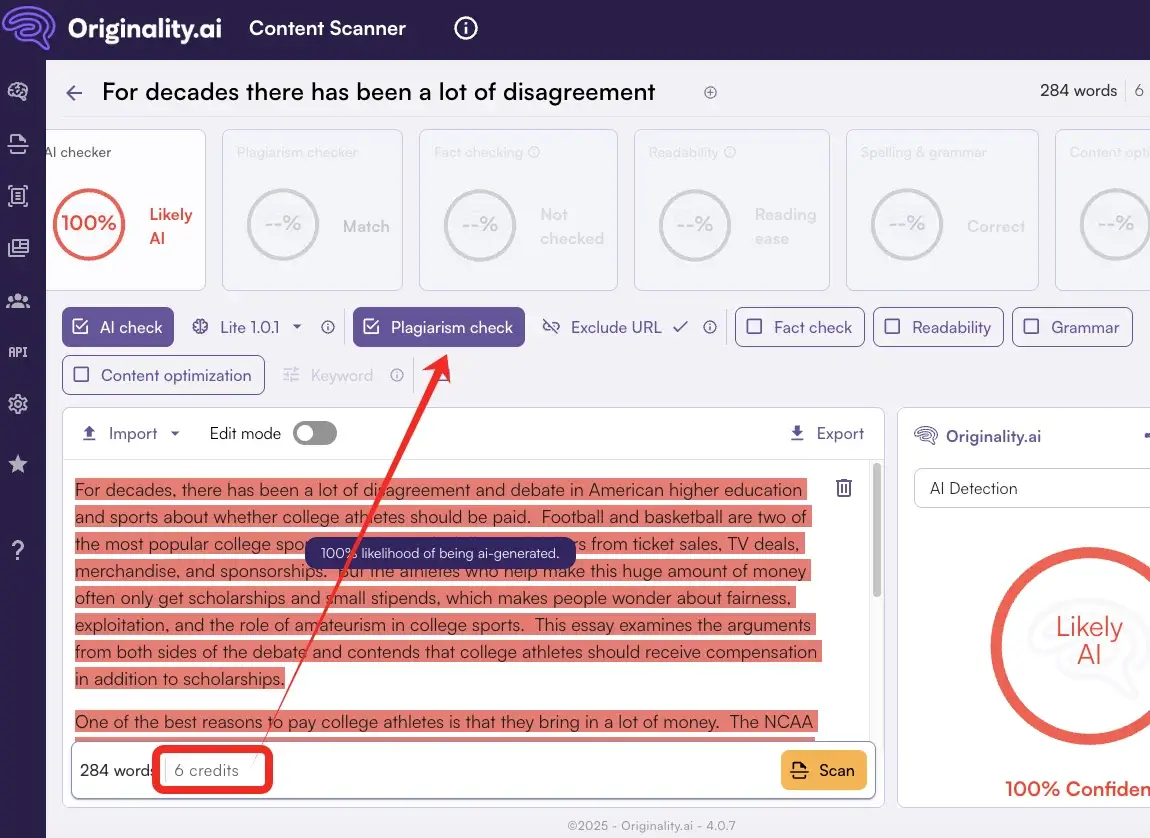
For example, scanning 100 English words costs 1 credit for AI detection, but 2 credits if you also check plagiarism. If you’re scanning long essays or multiple drafts, the cost can pile up fast.
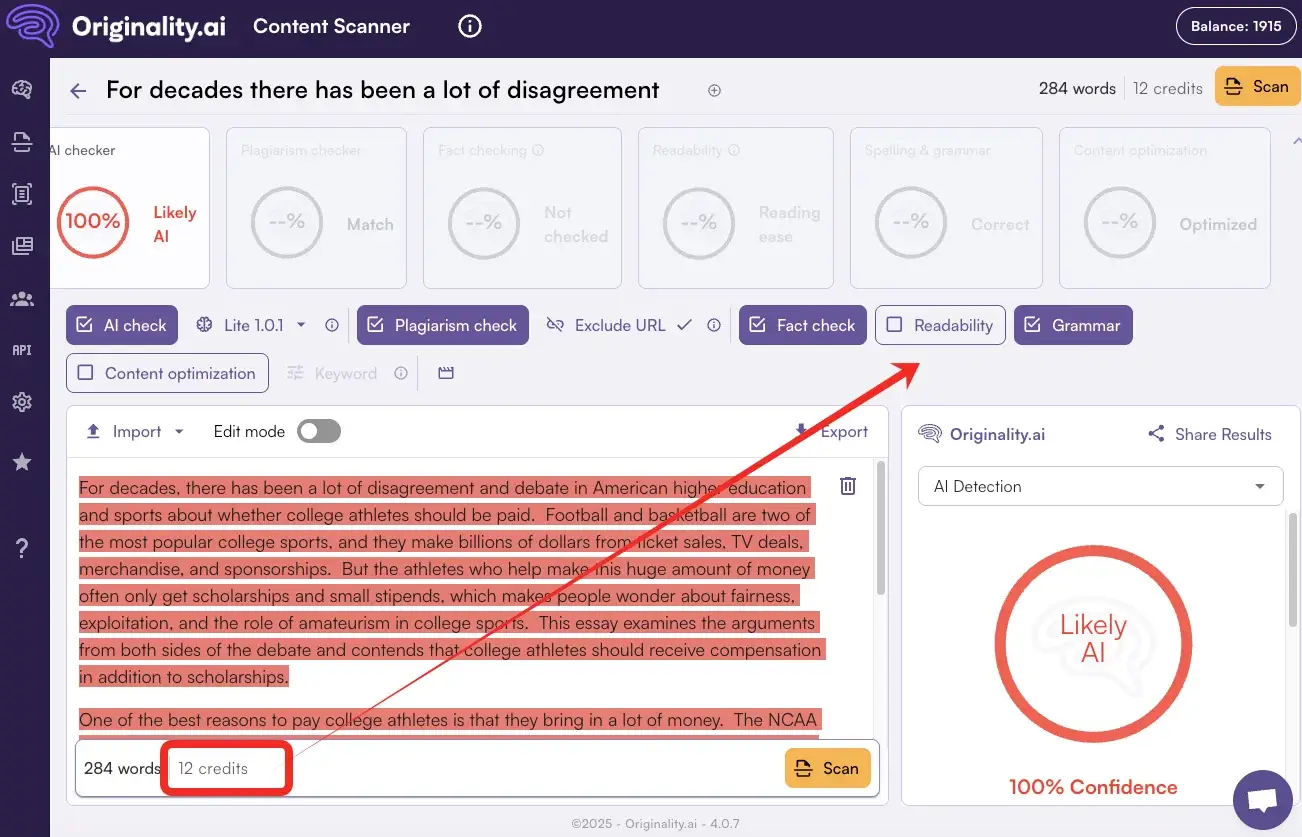
No Real Free Version: You only get a tiny handful of free scans. To use it seriously, you have to pay upfront, and there’s no unlimited free trial to explore the full tool.
Speed Isn’t the Best: Compared to some other detectors, Originality feels a little slower when processing longer texts. It’s not painfully slow, but if you’re checking big documents often, the wait can be noticeable.
Lack of Transparency: While it gives you a percentage score, the tool doesn’t fully explain why a passage is flagged. That makes it harder to challenge results when you know your work is genuinely your own.
Originality AI Detector Pricing
When it comes to pricing, Originality AI isn’t a free tool—you’ll only get a very small number of trial scans before you have to pay. That means if you’re curious about its full capabilities, you’ll need to put down some money fairly quickly.
Here’s how the main options break down:
Pay-As-You-Go Plan ($30 one-time): This gives you 3,000 credits, and they stay valid for up to two years. One credit covers about 100 words for AI or plagiarism detection. So if you’re checking a typical 1,000-word essay, that’s 10 credits right there. The nice thing about this option is you don’t have to commit to a subscription—it’s a one-time purchase.
Monthly Subscription ($12.95–$14.95/month): With this plan, you get 2,000 credits every month. It includes extras like the ability to upload files (PDF, DOCX, etc.), access your full scan history, and manage scans if you’re working with a small team. Basically, it’s better if you’re using the detector regularly rather than occasionally.
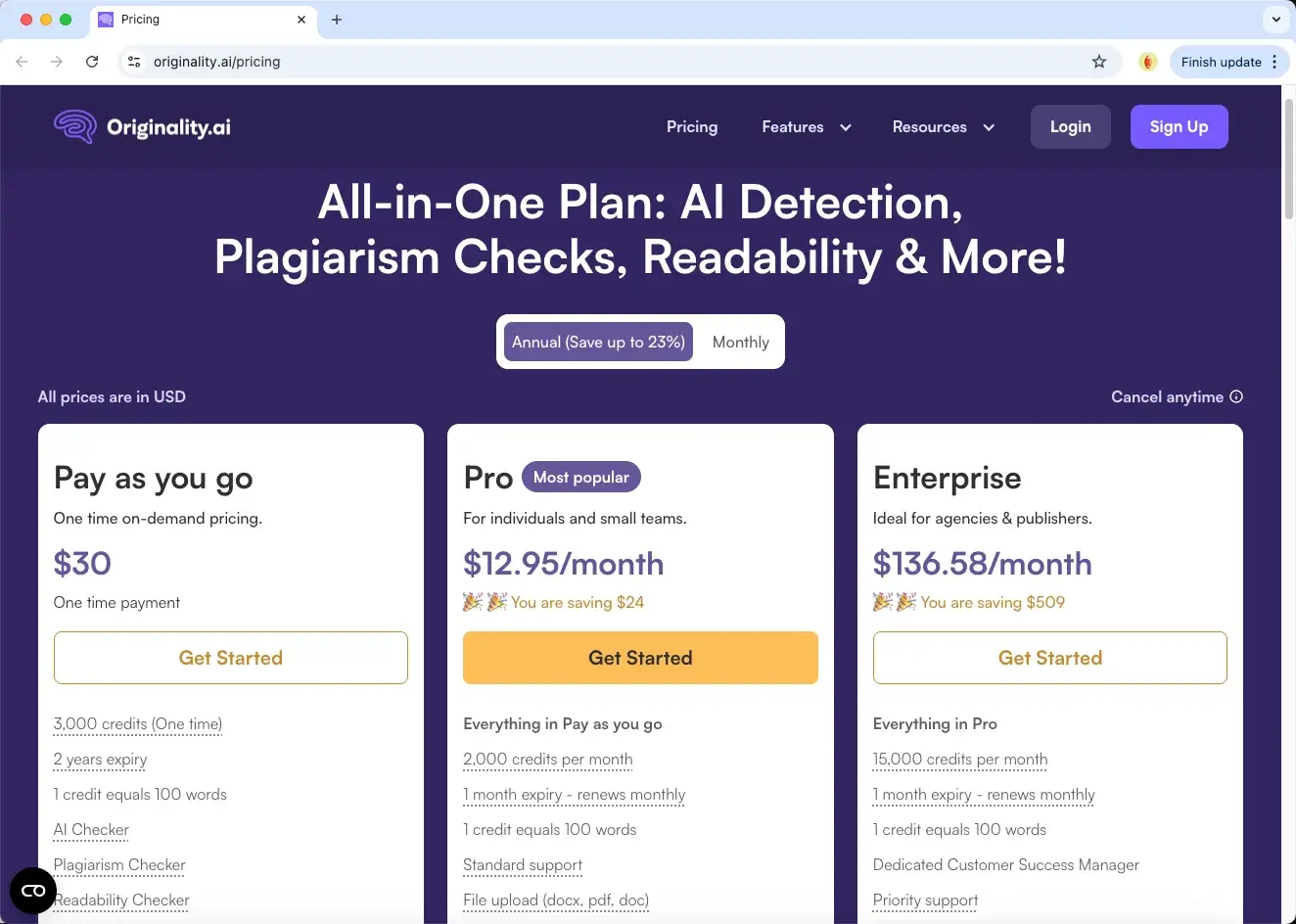
Enterprise Plan ($136.58/month): This is designed for agencies or publishers who need to scan large volumes of text. It comes with 15,000 credits a month, priority support, longer scan history, and API access so you can integrate it directly into your editorial workflow.
How to Bypass Originality AI Content Scanner?
By now, you might be asking yourself: Is it really possible to get past Originality AI’s detector? With such strict scoring, it feels almost impossible to make AI writing pass as human.
From my own tests, I can tell you it’s definitely not as simple as running text through a paraphrasing tool. In Test 3, I tried QuillBot’s “Advanced Humanization” mode, and the result was still flagged as 100% Likely AI. That told me the scanner isn’t just looking at vocabulary swaps—it’s analyzing sentence structures, flow, and patterns that AI writing tends to produce.
So, if you’re thinking about bypassing the detector, basic rewording won’t cut it. You’d need something more advanced, which is where specialized humanizers come into play.
EssayDone Humanizer
One of the tools built for this exact purpose is EssayDone Humanizer. Unlike a paraphraser that just replaces words, it rewrites text at a deeper level: restructuring sentences, shifting rhythm, and adjusting stylistic features that AI detectors usually pick up on.
Why does this matter? Originality AI is trained to recognize the statistical “fingerprints” of machine-generated writing. When those fingerprints are reshaped not just at the word level but at the structural level, the detector struggles to confidently flag the text as AI.
To put this to the test, I took the 100% AI-generated passage from Test 1 and ran it through EssayDone Humanizer. When I scanned the result back in Originality AI, the score dropped dramatically to 99% Likely Original (1% AI).
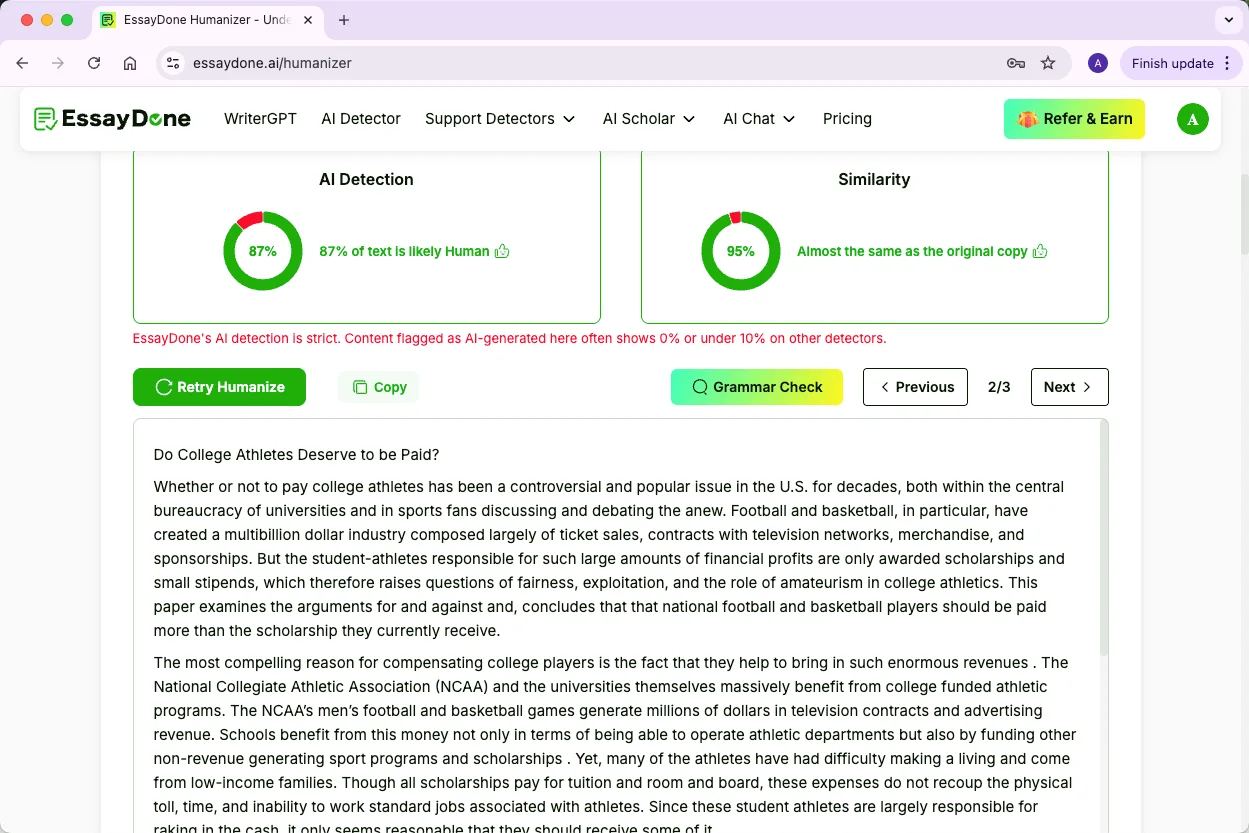
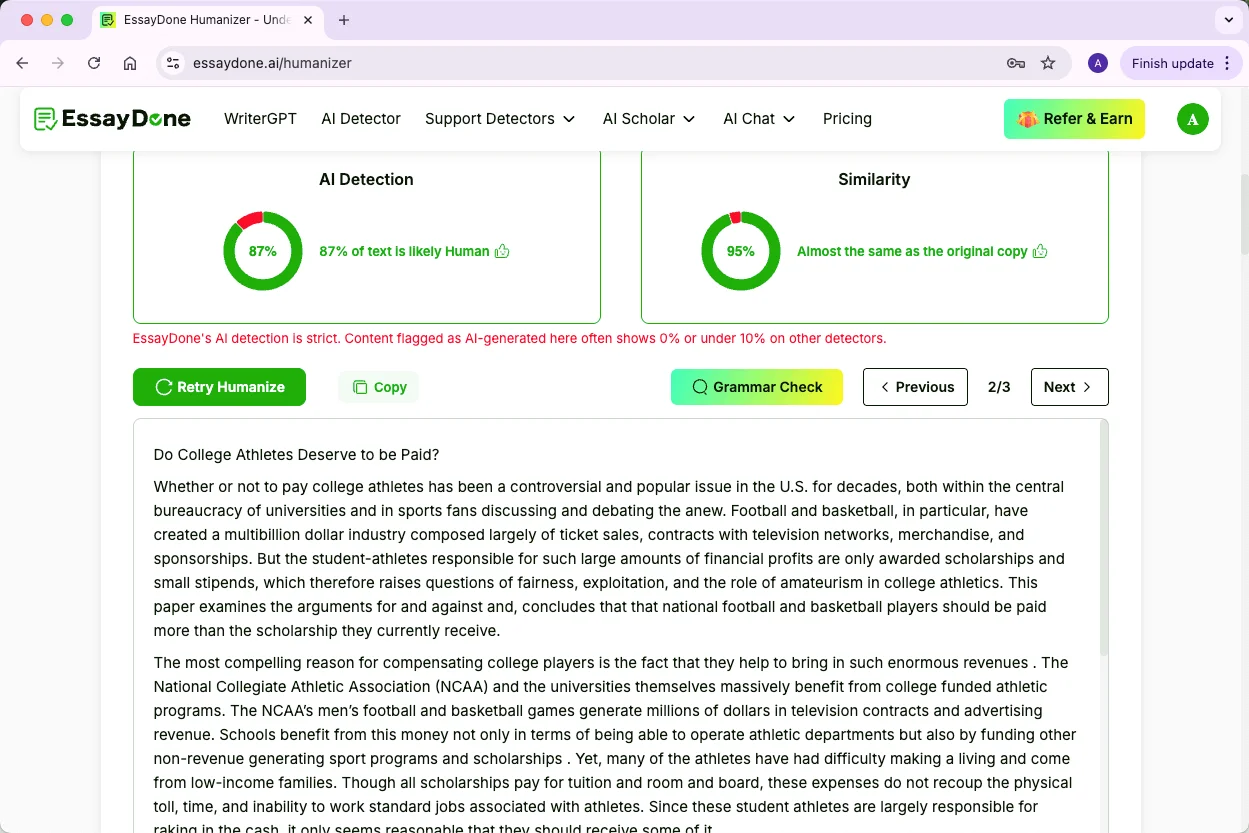
That’s a complete turnaround. It shows that while casual tricks like paraphrasing won’t bypass Originality AI, a professional humanizer tool can, at least in this case, make the text appear fully human.
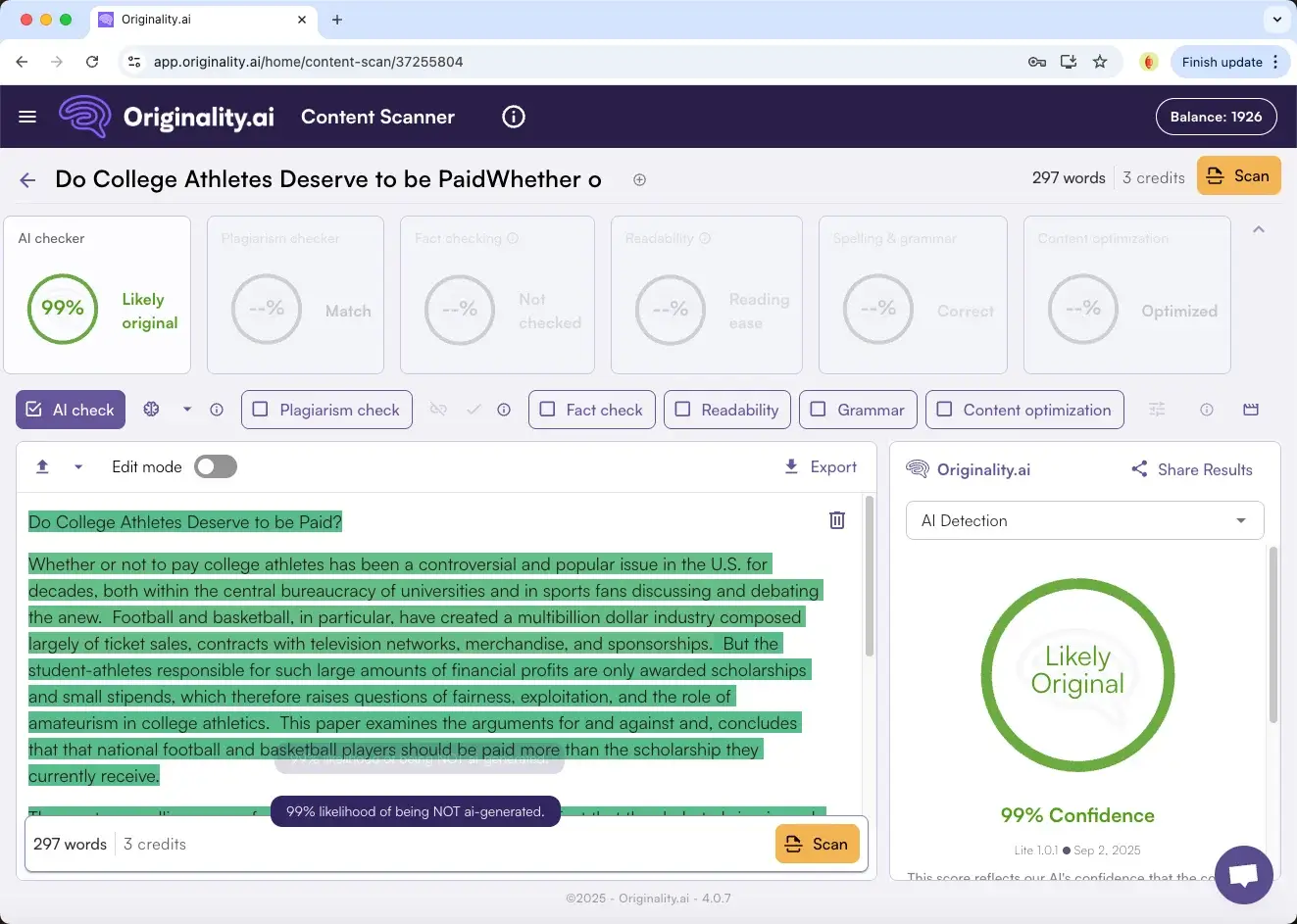
5 Alternatives to Originality AI Detector
While Originality AI is powerful, it isn’t the only option out there. Depending on your budget, language needs, or whether you want extra features like paraphrasing or citation tools, you might find another detector that fits better.
To give you a clearer picture, I’ve compared five of the most popular alternatives side by side, focusing on their free plans, pricing, file support, and standout features.
Tool | Multilingual | Free Plan | Paid Plan | File Formats | Login Required | Sentence-Level Analysis | Extra Features |
Grammarly | Yes | 10,000 characters/test | Yes for extra features | Type or paste only | Yes | No | Yes |
GPTZero | Yes | 5,000 characters/test | From $14.99/mo (100k chars) | PDF, DOC, DOCX, TXT (50MB max) | Yes | Yes | Writing feedback, plagiarism check, citation tools |
Copyleaks | Yes (30+ langs) | 15,000 characters/test | From $16.99/mo (100k chars) | Copy-paste only | No | No | AI + plagiarism in one report, shared data hub, Google Docs add-on, Chrome extension |
ZeroGPT | Yes | Yes | From $9.99/mo | Text only | No | No | Plagiarism check, AI summarizer, AI paraphraser |
QuillBot | Yes | 1,200 words/test | From $8.33/mo, Unlimited Scan with premium | Multiple (DOCX, TXT, etc.) | No | Yes | Paraphraser, summarizer, grammar check, plagiarism check, text humanizer |
FAQ
Is Originality AI detector 100% accurate?
No, not quite. From my own tests, I found it very good at catching raw AI text, but it struggles with mixed or humanized content. Even Originality AI itself doesn’t guarantee 100% accuracy—it claims up to 99%. That last 1% margin of error means false positives and false negatives are still possible.
How to bypass Originality AI detector?
If you try simple tricks like paraphrasing or word swaps (as I tested with QuillBot), you’ll likely still get flagged as AI. To really bypass it, you’d need a professional humanizer that changes sentence structures and linguistic patterns—something like EssayDone Humanizer, which I tested successfully.
Will my professor use an AI detector?
Many schools and universities have started adopting AI detectors like Originality AI, GPTZero, and Turnitin. But it depends on your professor’s policies and the institution. Some professors run everything through detectors, while others rely more on manual review.

Can I use AI detectors on my own work before submission?
Absolutely—and I recommend it. Running your essay through a detector like Originality AI can help you see if your work might raise suspicion. That way, you can fix potential issues before handing it in.
Are AI detectors legal?
Yes. Using AI detectors is legal for individuals, schools, and businesses. The bigger concern isn’t legality but fairness—sometimes detectors mislabel genuine human writing as AI, which can create disputes.
Is Originality AI detector free?
Not really. There’s no full free plan, just limited trial credits. To use all the features (AI detection, plagiarism check, readability, etc.), you’ll need a paid plan. The cheapest starts at $12.95/month or a $30 pay-as-you-go option.
Conclusion
In this review, I walked through how Originality AI detector works, its main pros and cons, pricing, and even whether it can be bypassed.
I also compared it with a few alternatives so you can see where it stands in the broader landscape of AI detectors. My goal was to show what you can realistically expect if you use it.
I hope this article helps you better understand AI detection and make more informed choices for your own writing.
